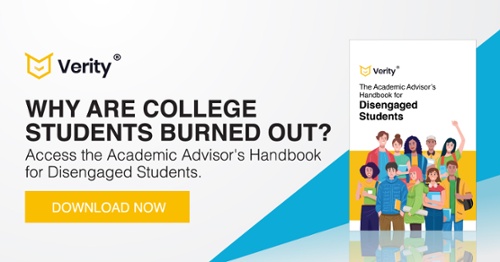4 College Student Retention Strategies You Can Implement Today
There are no shortcuts when it comes to student retention. Institutions need to deliver high-quality education that’s affordable, proves successful outcomes after graduation, and creates positive student experiences.
That said, there are college retention strategies you can implement that aren’t super costly or time-consuming to set up that can have a big impact on retention
Here are 4 best practices for college student retention.
1. Offer More Campus Involvement Opportunities
Campus involvement and student retention go hand in hand. In fact, studies have shown that students who attend campus events are 53.7% more likely to persist through to the next academic year than their non-engaged peers.
What can schools do about this?
It sounds simple—and it is—but encourage your students to get involved in campus activities, clubs, and organizations. Whether it’s student government, intramural sports, volunteering, robotics, history club, or anything else in which students are interested, create opportunities for them to get involved.
Engaging in extracurricular activities fosters a sense of community, encourages social connections, and enhances the overall student experience.

2. Create Early Intervention Initiatives
What happens at your school when students are struggling in their academic or personal lives?
If you don’t have a rock-solid plan in place, now is the time to create one.
As college student burnout is becoming more widespread, the drop-out rate is increasing. This is having a major impact on student retention.
Implement early alert systems to identify students who are struggling academically or emotionally. By intervening early to offer academic support, counseling services, or tutoring to help them overcome challenges, you can make a positive difference in their lives—and your retention rate.
What’s most important is that you catch these opportunities early. We show you exactly how to do this in our guide: The Academic Advisor's Handbook for Disengaged Students
3. Offer Student Success Workshops
So much of student success in college is directly linked to soft skills such as study habits, time management, and stress management. Unlike grade school or living at home, students are expected to track and balance all of these themselves without a parent or teacher holding their hand.
However, there is a gap in soft skills like these among college students today. Young students today are brilliant when it comes to technology, but have also become more and more dependent on technology for…just about everything.
According to the Workforce Institute, 34% of Gen Z Americans blame educational barriers for their lack of skills-based knowledge in the professional world.
One thing that Higher Ed institutions can do to help students overcome these challenges and provide another level of value is to offer workshops or seminars on these essential skills. Ask your students what they’d like to master and then help them become equipped with the tools they’ll need to thrive academically, professionally, and personally.
4. Collect Student Feedback and Evaluation
When you think about communication that happens on your campus, how much of it is only in one direction: the institution communicating to its students?
Each day, there is communication happening from the Registrar's Office, Student Housing, faculty members, and campus activity groups about deadlines, assignments, events, and more. But how often are students communicating back to the school?
Helping students embrace leadership opportunities, share their voices, and take ownership of their education experience goes a long way toward student retention.
Establish opportunities to gather feedback from students regularly and watch how engagement increases. Conduct surveys, focus groups, or feedback sessions to understand student concerns, preferences, and areas for improvement and you’ll see an immensely more involved, outspoken, and grateful student body.
Here’s the rub: you need to take action based on this feedback. Giving students a platform is one thing, but the follow-through is where the relationships are formed and trust is built. They’ll have wonderful ideas to make adjustments and improvements to enhance the college student experience.
We cover this more in our blog: 6 Things Every College Student Needs from their University
Who’s Responsible for Retaining College Students?
Short answer: everyone.
It can be easy to think the responsibility falls upon one department or another. But the truth is that every interaction, experience, and conversation contributes to the student’s perception of their school.
Improving student retention is not the responsibility of one person or department, it’s on everyone.
This is especially true when so many college students are having a hard time and may be even re-thinking the value of a college education as a whole.
To help catch signs of disengagement and build a plan to keep all of your students on track, download The Academic Advisor's Handbook for Disengaged Students.


